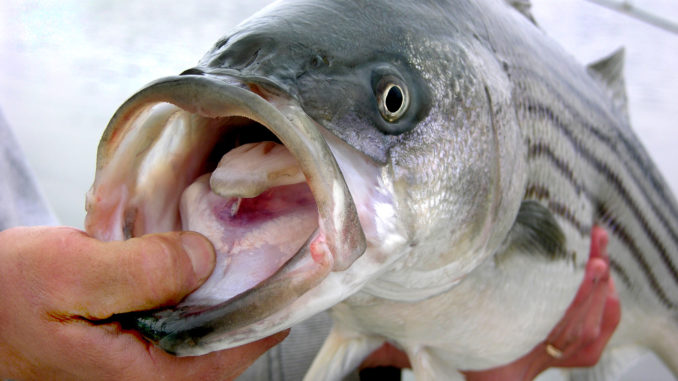
Target hybrid stripers this month whenever the sun is playing hard to get.
The Good Lord gave us a glorious sunrise, the glowing orb back-lighting a cloud in the eastern sky that looked for all the world like an angel in flight. I snapped a few photos as the sun slowly nibbled away the cloud bank. In a matter of minutes, the sun did what it has been doing for the past month, sending its searing heat down on us.
Ruston photographer Kevin Beasley and I were motoring slowly across the surface of Lake Claiborne, looking for the tell-tale swirls of hybrid stripers feeding on threadfin shad; they’d been doing that every morning for weeks. We searched and sweated in vain for nearly an hour without seeing a single feeding fish.
Then that same sun that had mesmerized us earlier slipped behind another cloud bank, and that action triggered the fish into feeding. For 15 minutes, the cloud cover we enjoyed briefly put the stripers into action; they were popping the top of the water here; then over there; then back here again. Just as quickly as it began, it was over when the sun popped back out again, and all was quiet on the lake’s surface. During that brief flurry of activity, we caught three hybrids before giving in to the sun and calling it a day.
To add credence to the advantages of having a cloud cover to trigger a feeding frenzy, Beasley and a friend went a week after our trip on a morning with clouds that threatened rain.
“Once the sky became overcast, it was something to see; they were coming up everywhere,” Beasley said. “My partner, Steve Lee, and I caught more than 40 fish up to 4 pounds that morning.”
The hybrid stripers living in the waters of North Carolina are called “Bodie Bass,” officially named after retired long-time outdoor writer and conservation officer from Greensboro, Bodie McDowell. Here in Louisiana, they could be called a variety of names. “Cloud Dancers” comes to mind because of their tendency to perform pirouettes on the surface more readily under a cloud cover.
The fish we caught were attracted to shad-imitation lures, principally a topwater chugger or a gray/chartreuse Cocahoe skewered onto a grub head.
Mike Wood, director of inland fisheries for the LDWF, suggested another way he has had good success in fishing for hybrids.
“I’ll use a cast net to catch some threadfin shad,” said Wood. “I’ll put a shad on a hook under a slip cork, drop it down to the thermocline and hang on; they’ll really attack these baitfish.”
I recalled when stripers were first stocked in Lake Claiborne, there was a bevy of opposition mainly from bass fishermen who suspected that the stripers were scarfing down baby bass.
“We did a food study early on to try and determine if this was in fact the case,” Wood said. “We sampled thousands of stomachs of these fish and found only a few that had small bass or crappie. Their food of choice is shad.”
Want to beat the heat and have some fishing fun? Be on lakes where they are regularly stocked — Lake Claiborne, Lake Bruin or False River — at sun-up and watch for hybrids dancing on top. It can be a blast, especially if the sun decides to hide behind a cloud for a spell. That’s when the “Cloud Dancers” take center stage.